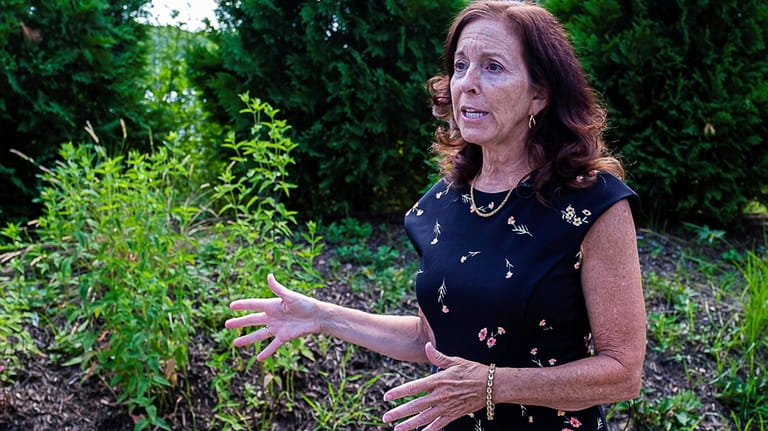EPA proposes hazardous designation for two 'forever chemicals'

PFOA and PFOS have been voluntarily phased out by U.S. manufacturers but still remain in the environment because they do not degrade over time. Increasingly, they are found in drinking water. Credit: Newsday/Steve Pfost
The U.S. Environmental Protection Agency’s proposal of designating as hazardous two of the most common “forever chemicals” found in items such as a cookware and carpets was met with support and enthusiasm by area environmental advocates, who dubbed the announcement a “milestone.”
The EPA on Friday announced plans to protect communities from health risks posed by toxic compounds called PFAS, also known as “forever chemicals.” The agency is proposing to designate two of the most common substances — PFOA and PFOS — as hazardous.
PFAS — which have been used in nonstick frying pans, water-repellent sports gear, stain-resistant rugs, cosmetics and other consumer products — can accumulate and persist in the human body for long periods. Evidence from animal and human studies indicates that exposure to PFOA or PFOS may lead to cancer or other health problems.
PFOA and PFOS have been voluntarily phased out by U.S. manufacturers but still remain in the environment because they do not degrade over time. Increasingly, they are found in drinking water.
On Long Island, the two substances have been found in hundreds of public and private wells since around 2016. Water providers bring contaminants down to nondetectable levels in the water supply using granular activated carbon filters.
The Long Island Water Conference, which represents water providers, has said hundreds of millions of dollars have been spent locally to test for and treat PFOA and PFOS, which stand for perfluorooctanoic acid and perfluorooctanesulfonic acid, respectively.

Adrienne Esposito. Credit: Jeff Bachner
“We have found that the public is extremely concerned about the quality of drinking water, and they're very interested in it," said Adrienne Esposito, executive director and co-founder of the Citizens Campaign for the Environment. "The need and discussion of clean water on Long Island is one that we’ve had with the public continuously."
Citizens Campaign for the Environment works to strengthen environmental policies and educate the public on Long Island and statewide.
In an announcement about the proposal, the EPA said the designation would increase transparency around releases of the harmful chemicals and hold polluters accountable. The designation as harmful substances means that releases of PFOA and PFOS that exceed a certain level would have to be reported to authorities, who could require cleanups.
State DEC Commissioner Basil Seggos, who called the announcement a “milestone,” said the EPA’s move will “result in reducing human and environmental exposure to these emerging contaminants and prevent these chemicals from entering our communities and drinking water supplies.”
The EPA in June announced that PFOA and PFOS are more dangerous than previously thought and pose health risks even at levels so low they cannot currently be detected. The agency issued nonbinding health advisories that set health risk thresholds for PFOA and PFOS to near zero.
Esposito called the EPA’s announcement “a game changer and a call to action.”
“Right now we need the state to reevaluate the current drinking water standard and increase protective measures,” she said.
New York in July 2020 became the first state in the country to adopt drinking water standards for another contaminant, 1,4-dioxane, an industrial solvent, at 1 part per billion. The dangerous chemical has been found in more than 70% of public water wells on Long Island. The state also set maximum contaminant levels of 10 parts per trillion each for PFOS and PFOA.
To provide time for the building of treatment systems, the state at the time approved deferrals of up to two years for 21 of more than the 50 public water providers on Long Island. These 21 providers had wells approaching or exceeding the state limit for the three "emerging contaminants," and the deferrals allowed them to continue pumping water without receiving violations.
Providers say they shut down some troubled wells or blended that water with water from clean wells to lower the level of contaminants below state limits. This year, numerous providers requested and received another deferral of up to a year.
Going into effect on Dec. 31, new legislation will prohibit the distribution of food packaging containing intentionally added PFAS substances.
“We need to be as diligent and protective of public health as we can be,” Esposito said.
With AP, Vera Chinese and Craig Schneider
Brush fire at Lakeland Park ... Offshore wind projects cancelled ... Pitbull at Jones Beach ... Jericho H.S. ranks top
Brush fire at Lakeland Park ... Offshore wind projects cancelled ... Pitbull at Jones Beach ... Jericho H.S. ranks top

